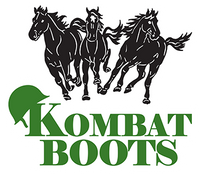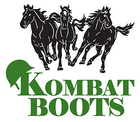Kombat Boots Science
No one “makes yeast.” Yeast is a naturally occurring fungus and is found all around us. There are numerous strains of yeast, most of which are inedible. Some are even poisonous. Yeast is a single cell fungus easily manipulated by nature or by man in a laboratory.
“Bakers” yeast has been around for centuries and is the strain used in the baking process. “Brewers” yeast is a strain of bakers yeast and has been used for brewing alcoholic beverages for hundreds of years. Kombat Boots is made from the residue left over from the brewing process. This residual yeast has been used for hundreds of years in animal feed.
Yeast is one of nature’s “perfect” foods. There are no side effects. Pound for pound, nothing compares with yeast for nutritive value. When fed to horses, brewers yeast does some interesting things. The yeast cell wall is a carbohydrate. When the cell wall is broken down by the digestive juices, a large quantity of carbon dioxide is created. Since a horse cannot “belch,” this CO-2 remains in the stomach and “scavenges” the oxygen out of the digestive system. The “bad bacteria” such as E. coli and salmonella need this oxygen. The bad bacteria are greatly reduced, if not eliminated, from the digestive system by a lack of oxygen. The CO-2 allows the digestive bacteria and enzymes to increase. They do not need oxygen. The result is an increase in the digestive capacity of the horse.
The CO-2 also increases the amount of carbonic acid in the digestive system which permeates the neuro-muscular system and lowers the amount of lactic acid buildup in the working muscles. Additionally, the contents of the yeast cell are an excellent source of vitamins and minerals.
The benefits of yeast have been known for years, but the problem has always been – how do you get it into the horse? No one, until now, has been able to produce a yeast pellet horses will eat. Most modern feed pellets contain small amounts of yeast. The Kombat Boots pellet contains 70% yeast. Most horses love the apple taste; they will eat the pellets right out of your hand!
Research studies done in the past twenty-five years also confirm the beneficial effects of feeding yeast to horses. Just a sampling of these studies shows the following:
“Bakers” yeast has been around for centuries and is the strain used in the baking process. “Brewers” yeast is a strain of bakers yeast and has been used for brewing alcoholic beverages for hundreds of years. Kombat Boots is made from the residue left over from the brewing process. This residual yeast has been used for hundreds of years in animal feed.
Yeast is one of nature’s “perfect” foods. There are no side effects. Pound for pound, nothing compares with yeast for nutritive value. When fed to horses, brewers yeast does some interesting things. The yeast cell wall is a carbohydrate. When the cell wall is broken down by the digestive juices, a large quantity of carbon dioxide is created. Since a horse cannot “belch,” this CO-2 remains in the stomach and “scavenges” the oxygen out of the digestive system. The “bad bacteria” such as E. coli and salmonella need this oxygen. The bad bacteria are greatly reduced, if not eliminated, from the digestive system by a lack of oxygen. The CO-2 allows the digestive bacteria and enzymes to increase. They do not need oxygen. The result is an increase in the digestive capacity of the horse.
The CO-2 also increases the amount of carbonic acid in the digestive system which permeates the neuro-muscular system and lowers the amount of lactic acid buildup in the working muscles. Additionally, the contents of the yeast cell are an excellent source of vitamins and minerals.
The benefits of yeast have been known for years, but the problem has always been – how do you get it into the horse? No one, until now, has been able to produce a yeast pellet horses will eat. Most modern feed pellets contain small amounts of yeast. The Kombat Boots pellet contains 70% yeast. Most horses love the apple taste; they will eat the pellets right out of your hand!
Research studies done in the past twenty-five years also confirm the beneficial effects of feeding yeast to horses. Just a sampling of these studies shows the following:
- Improvements in the growth of young horses:
Weanlings fed yeast culture were five kg. heavier and had a 10% faster growth rate than those not fed yeast cultures over a six-month period. Ciro (1991). - Improvements in the aerobic metabolic capacity of horses in training.
Campbell & Glade (1989) reported lower plasma lactic acid concentrations after 35 minutes of exercise and lower heart rates during the first five minutes and last ten minutes of a 35-minute workout for horses fed yeast. - Improvements in a broodmare’s early milk production and increased foal growth.
Mares supplemented with yeast during the first two weeks of lactation produced 35.4 lbs. of milk per day compared with 31.7 lbs. for mares not fed yeast. Glade (1991). Foals of mares fed yeast were 57 lbs. heavier and 3.5 inches taller at the withers at 56 days of age than foals from mares not fed yeast. Glade (1991).



